Effects of Mulch and Fertilization on the Quantity and Quality of Perennial Wall–Rocket (Diplotaxis tenuifolia)
Abstract
1. Introduction
2. Results
2.1. Individual Influences of Factors on the Characteristics of Perennial Wall–Rocket
2.2. Cumulative Influence of Factors on the Characteristics of Perennial Wall–Rocket
2.3. Dimensionality Reduction and Exploratory Causal Statistical Analysis of Data
3. Discussion
4. Materials and Methods
4.1. Design of the Experiment and Research Protocol
4.2. Analytical Methods for the Evaluation of Analyzed Parameters
4.3. Statistical Analysis of the Results
5. Conclusions
Author Contributions
Funding
Data Availability Statement
Acknowledgments
Conflicts of Interest
References
- Ressurreição, S.; Salgueiro, L.; Figueirinha, A. Diplotaxis genus: A promising source of compounds with nutritional and biological properties. Molecules 2024, 29, 2612. [Google Scholar] [CrossRef] [PubMed]
- Bonasia, A.; Lazzizera, C.; Elia, A.; Conversa, G. Nutritional, biophysical and physiological characteristics of wild rocket genotypes as affected by soilless cultivation system, salinity level of nutrient solution and growing period. Front. Plant Sci. 2017, 8, 300. [Google Scholar] [CrossRef] [PubMed]
- Signore, A.; Amoruso, F.; Gallegos-Cedillo, V.M.; Gómez, P.A.; Ochoa, J.; Egea-Gilabert, C.; Costa-Pérez, A.; Domínguez-Perles, R.; Moreno, D.A.; Pascual, J.A.; et al. Agro-industrial compost in soilless cultivation modulates the vitamin C content and phytochemical markers of plant stress in rocket salad (Diplotaxis tenuifolia (L.) DC.). Agronomy 2023, 13, 544. [Google Scholar] [CrossRef]
- Tallarita, A.V.; Golubkina, N.; De Pascale, S.; Sękara, A.; Pokluda, R.; Murariu, O.C.; Cozzolino, E.; Cenvinzo, V.; Caruso, G. Effects of selenium/iodine foliar application and seasonal conditions on yield and quality of perennial wall rocket. Horticulturae 2025, 11, 211. [Google Scholar] [CrossRef]
- Roșca, M.; Mihalache, G.; Teliban, G.C.; Butnariu, M.; Covașa, M.; Cara, I.G.; Rusu, O.R.; Hlihor, R.M.; Ruocco, M.; Stoleru, V. Assessment of perennial wall-rocket (Diplotaxis tenuifolia) growth under Pb(II) stress–preliminary studies. Acta Hortic. 2025, 1416, 445–452. [Google Scholar] [CrossRef]
- Caruso, G.; Parrella, G.; Giorgini, M.; Nicoletti, R. Crop systems, quality and protection of Diplotaxis tenuifolia. Agriculture 2018, 8, 55. [Google Scholar] [CrossRef]
- Signore, A.; Renna, M.; Santamaria, P. Agrobiodiversity of Vegetable Crops: Aspect, Needs, and Future Perspectives. In Annual Plant Reviews Online; Roberts, J.A., Ed.; Wiley: Hoboken, NJ, USA, 2019; pp. 41–64. ISBN 978-1-119-31299-4. [Google Scholar]
- Chen, M.; Zhang, T.-L.; Hu, C.-G.; Zhang, J.-Z. The role of drought and temperature stress in the regulation of flowering time in annuals and perennials. Agronomy 2023, 13, 3034. [Google Scholar] [CrossRef]
- Leijten, W.; Koes, R.; Roobeek, I.; Frugis, G. Translating flowering time from Arabidopsis thaliana to Brassicaceae and Asteraceae crop species. Plants 2018, 7, 111. [Google Scholar] [CrossRef]
- Morales, M.R.; Janick, J.; Whipkey, A. Arugula: A promising specialty leaf vegetable. In Proceedings of the Trends in New Crops and New Uses—The Fifth National Symposium, Atlanta, GA, USA, 10–13 November 2001; pp. 418–423. [Google Scholar]
- Nicoletti, R.; Raimo, F.; Miccio, G. Diplotaxis tenuifolia: Biology, production and properties. Eur. J. Plant Sci. Biotechnol. 2007, 1, 36–43. [Google Scholar]
- Scarano, A.; Semeraro, T.; Chieppa, M.; Santino, A. Neglected and underutilized plant species (NUS) from the Apulia Region Worthy of being rescued and re-included in daily diet. Horticulturae 2021, 7, 177. [Google Scholar] [CrossRef]
- Bantis, F.; Kaponas, C.; Charalambous, C.; Koukounaras, A. Strategic successive harvesting of rocket and spinach baby leaves enhanced their quality and production efficiency. Agriculture 2021, 11, 465. [Google Scholar] [CrossRef]
- Tang, Z.; Lu, J.; Xiang, Y.; Shi, H.; Sun, T.; Zhang, W.; Wang, H.; Zhang, X.; Li, Z.; Zhang, F. Farmland mulching and optimized irrigation increase water productivity and seed yield by regulating functional parameters of soybean (Glycine max L.) leaves. Agric. Water Manag. 2024, 298, 108875. [Google Scholar] [CrossRef]
- Iqbal, R.; Raza, M.A.S.; Valipour, M.; Saleem, M.F.; Zaheer, M.S.; Ahmad, S.; Toleikiene, M.; Haider, I.; Aslam, M.U.; Nazar, M.A. Potential agricultural and environmental benefits of mulches—A review. Bull. Natl. Res. Cent. 2020, 44, 75. [Google Scholar] [CrossRef]
- Wang, X.; Fan, J.; Xing, Y.; Xu, G.; Wang, H.; Deng, J.; Wang, Y.; Zhang, F.; Li, P.; Li, Z. Chapter Three—The Effects of Mulch and Nitrogen Fertilizer on the Soil Environment of Crop Plants. In Advances in Agronomy; Sparks, D.L., Ed.; Academic Press: Cambridge, MA, USA, 2019; Volume 153, pp. 121–173. [Google Scholar]
- Ma, D.; Chen, L.; Qu, H.; Wang, Y.; Misselbrook, T.; Jiang, R. Impacts of plastic film mulching on crop yields, soil water, nitrate, and organic carbon in northwestern China: A meta-analysis. Agric. Water Manag. 2018, 202, 166–173. [Google Scholar] [CrossRef]
- Hazrati, S.; Mousavi, Z.; Mollaei, S.; Sedaghat, M.; Mohammadi, M.; Pignata, G.; Nicola, S. Optimizing Nitrogen fertilization to maximize yield and bioactive compounds in Ziziphora clinopodioides. Agriculture 2024, 14, 1690. [Google Scholar] [CrossRef]
- Troiano, S.; Novelli, V.; Geatti, P.; Marangon, F.; Ceccon, L. Assessment of the sustainability of wild rocket (Diplotaxis tenuifolia) production: Application of a multi-criteria method to different farming systems in the Province of Udine. Ecol. Indic. 2019, 97, 301–310. [Google Scholar] [CrossRef]
- Stanojković-Sebić, A.; Miladinović, V.; Stajković-Srbinović, O.; Pivić, R. Response of arugula to integrated use of biological, inorganic, and organic fertilization. Microorganisms 2024, 12, 1334. [Google Scholar] [CrossRef]
- Hall, M.K.D.; Jobling, J.J.; Rogers, G.S. Fundamental differences between perennial wall rocket and annual garden rocket influence the commercial year-round supply of these crops. J. Agric. Sci. 2015, 7, p1. [Google Scholar] [CrossRef][Green Version]
- Reis, J.M.; Pereira, R.J.; Coelho, P.S.; Leitão, J.M. Assessment of wild rocket (Diplotaxis tenuifolia (L.) DC.) germplasm accessions by NGS identified SSR and SNP markers. Plants 2022, 11, 3482. [Google Scholar] [CrossRef]
- Stajnko, D.; Berk, P.; Orgulan, A.; Gomboc, M.; Kelc, D.; Rakun, J. Growth and glucosinolate profiles of Eruca sativa (Mill.) (rocket salad) and Diplotaxis tenuifolia (L.) DC. under different LED lighting regimes. Plant Soil Environ. 2022, 68, 466–478. [Google Scholar] [CrossRef]
- Guijarro-Real, C.; Adalid-Martínez, A.M.; Aguirre, K.; Prohens, J.; Rodríguez-Burruezo, A.; Fita, A. Growing conditions affect the phytochemical composition of edible wall rocket (Diplotaxis erucoides). Agronomy 2019, 9, 858. [Google Scholar] [CrossRef]
- El-Beltagi, H.S.; Basit, A.; Mohamed, H.I.; Ali, I.; Ullah, S.; Kamel, E.A.R.; Shalaby, T.A.; Ramadan, K.M.A.; Alkhateeb, A.A.; Ghazzawy, H.S. Mulching as a sustainable water and soil saving practice in agriculture: A review. Agronomy 2022, 12, 1881. [Google Scholar] [CrossRef]
- Di Mola, I.; Cozzolino, E.; Ottaiano, L.; Riccardi, R.; Spigno, P.; Petriccione, M.; Fiorentino, N.; Fagnano, M.; Mori, M. Biodegradable mulching film vs. traditional polyethylene: Effects on yield and quality of San Marzano tomato fruits. Plants 2023, 12, 3203. [Google Scholar] [CrossRef] [PubMed]
- Caruso, G.; De Pascale, S.; Nicoletti, R.; Cozzolino, E.; Rouphael, Y. Productivity, nutritional and functional qualities of perennial wall-rocket: Effects of pre-harvest factors. Folia Hortic. 2019, 31, 71–80. [Google Scholar] [CrossRef]
- Lamont, W.J. Plastic Mulches for the Production of Vegetable Crops. In A Guide to the Manufacture, Performance, and Potential of Plastics in Agriculture; Elsevier: Amsterdam, The Netherlands, 2017; pp. 45–60. ISBN 978-0-08-102170-5. [Google Scholar]
- Stefanelli, D.; Goodwin, I.; Jones, R. Minimal nitrogen and water use in horticulture: Effects on quality and content of selected nutrients. Food Res. Int. 2010, 43, 1833–1843. [Google Scholar] [CrossRef]
- Mahadeen, A.Y. Effect of polyethylene black plastic mulch on growth and yield of two summer vegetable crops under rain-fed conditions under semi-arid region conditions. Am. J. Agric. Biol. Sci. 2014, 9, 202–207. [Google Scholar] [CrossRef]
- He, G.; Wang, Z.; Hui, X.; Huang, T.; Luo, L. Black film mulching can replace transparent film mulching in crop production. Field Crops Res. 2021, 261, 108026. [Google Scholar] [CrossRef]
- Ban, D.; Žanić, K.; Dumičić, G.; Gotlin Čuljak, T.; Goreta Ban, S. The type of polyethylene mulch impacts vegetative growth, yield, and aphid populations in watermelon production. J. Food Agric. Environ. 2009, 7, 543–550. [Google Scholar]
- Tayoh, L.N. Destruction of soil health and risk of food contamination by application of chemical fertilizer. In Ecological and Practical Applications for Sustainable Agriculture; Bauddh, K., Kumar, S., Singh, R.P., Korstad, J., Eds.; Springer: Singapore, 2020; pp. 53–64. ISBN 978-981-15-3372-3. [Google Scholar]
- Antonious, G. The impact of organic, inorganic fertilizers, and biochar on phytochemicals content of three Brassicaceae vegetables. Appl. Sci. 2023, 13, 8801. [Google Scholar] [CrossRef]
- Precupeanu, C.; Munteanu, N.; Caruso, G.; Rădeanu, G.; Teliban, G.C.; Cojocaru, A.; Stan, T.; Popa, L.D.; Stoleru, V. Preliminary studies on biology and harvest technology at Diplotaxis tenuifolia (L.) D.C. Acta Hortic. 2024, 1391, 321–328. [Google Scholar] [CrossRef]
- Teliban, G.-C.; Caruso, G.; Munteanu, N.; Cojocaru, A.; Popa, L.-D.; Stoleru, V. Greenhouse perennial wall-rocket crop as influenced by mulching and fertilization practices. Sci. Papers Ser. B Hortic. 2020, LXIV, 474–480. [Google Scholar]
- Precupeanu, C.; Rădeanu, G.; Teliban, G.C.; Caruso, G.; Stoleru, V. Interaction effect of planting time, mulching and fertilization on perennial wall-rocket. Acta Hortic. 2025, 1416, 537–544. [Google Scholar] [CrossRef]
- Caruso, G.; Stoleru, V.; De Pascale, S.; Cozzolino, E.; Pannico, A.; Giordano, M.; Teliban, G.; Cuciniello, A.; Rouphael, Y. Production, leaf quality and antioxidants of perennial wall rocket as affected by crop cycle and mulching type. Agronomy 2019, 9, 194. [Google Scholar] [CrossRef]
- Saeid, A.; Mohammed, G. The effect of color plastic mulches on growth, yield and quality of two hybrids of summer squash (Cucurbita pepo L.). Sci. J. Univ. Zakho 2015, 3, 113–118. [Google Scholar] [CrossRef]
- Franquera, E.N. Effects of plastic mulch color on the total soluble solids, total sugars and chlorophyll content of lettuce (Lactuca sativa L.). Int. J. Res. Agric. For. 2015, 2, 18–24. [Google Scholar]
- Martins, T.; Barros, A.N.; Rosa, E.; Antunes, L. Enhancing health benefits through chlorophylls and chlorophyll-rich agro-food: A comprehensive review. Molecules 2023, 28, 5344. [Google Scholar] [CrossRef]
- Pérez-Gálvez, A.; Viera, I.; Roca, M. Carotenoids and chlorophylls as antioxidants. Antioxidants 2020, 9, 505. [Google Scholar] [CrossRef]
- Keçe, Y.M.; Yetişir, H.; Güneş, A. Effect of organic and chemical fertilizer applications on yield and chlorophyll content of yedikule lettuce (Lactuva sativa L.) plant. BIO Web Conf. 2024, 85, 01076. [Google Scholar] [CrossRef]
- Da Cruz Bento, B.M.; França, A.C.; Oliveira, R.G.; Sardinha, L.T.; Soares Leal, F.D. Organic fertilization attenuates heat stress in lettuce cultivation. Acta Agron. 2020, 69, 84267. [Google Scholar] [CrossRef]
- Amare, G.; Desta, B. Coloured plastic mulches: Impact on soil properties and crop productivity. Chem. Biol. Technol. Agric. 2021, 8, 4. [Google Scholar] [CrossRef]
- Tarara, J.M. Microclimate modification with plastic mulch. HortSci 2000, 35, 169–180. [Google Scholar] [CrossRef]
- Gheshm, R.; Brown, R.N. The effects of black and white plastic mulch on soil temperature and yield of crisphead lettuce in southern New England. HortTechnology 2020, 30, 781–788. [Google Scholar] [CrossRef]
- Song, J.; Jia, H.; Wang, Y.; Zhang, X.; Yang, W.; Zhang, T.; Wang, N.; Yang, J.; Wang, H. Evaluation of the effects of degradable mulching film on the growth, yield and economic benefit of garlic. Agronomy 2025, 15, 93. [Google Scholar] [CrossRef]
- Zhao, Y.; Zhang, F.; Li, L.; Yang, X.; Zhang, F.; Zhao, W.; He, Q. Substitution Experiment of biodegradable paper mulching film and white plastic mulching film in Hexi Oasis irrigation area. Coatings 2022, 12, 1225. [Google Scholar] [CrossRef]
- Caruso, G.; Formisano, L.; Cozzolino, E.; Pannico, A.; El-Nakhel, C.; Rouphael, Y.; Tallarita, A.; Cenvinzo, V.; De Pascale, S. Shading affects yield, elemental composition and antioxidants of perennial wall rocket crops grown from spring to summer in southern Italy. Plants 2020, 9, 933. [Google Scholar] [CrossRef]
- Nafziger, E. Soil Temperatures and Fall Ammonia Application. Available online: https://origin.farmdocdaily.illinois.edu/2019/10/soil-temperatures-and-fall-ammonia-application.html (accessed on 20 March 2025).
- Horwath, W. 12-Carbon Cycling and Formation of Soil Organic Matter. In Soil Microbiology, Ecology and Biochemistry, 3rd ed.; Paul, E.A., Ed.; Academic Press: San Diego, CA, USA, 2007; pp. 303–339. ISBN 978-0-12-546807-7. [Google Scholar]
- Liu, Y.; Lan, X.; Hou, H.; Ji, J.; Liu, X.; Lv, Z. Multifaceted ability of organic fertilizers to improve crop productivity and abiotic stress tolerance: Review and perspectives. Agronomy 2024, 14, 1141. [Google Scholar] [CrossRef]
- Stoleru, V.; Teliban, G.C.; Cojocaru, A.; Rusu, O.R.; Stan, T.; Gutui, B.; Munteanu, N.; Lobiuc, A. Future perspectives of organic and conventional fertilizers on the morphological and yield parameters of tomato. Acta Hortic. 2025, 1416, 177–184. [Google Scholar] [CrossRef]
- Chiriță, R.; Apostol, M.; Teliban, G.C.; Stan, T.; Jacobsen, S.E.; Stoleru, V. Abiotic stress effect on quinoa species (Chenopodium quinoa Willd.) under fertilization management. Acta Hortic. 2025, 1416, 479–486. [Google Scholar] [CrossRef]
- Fracchiolla, M.; Renna, M.; D’Imperio, M.; Lasorella, C.; Santamaria, P.; Cazzato, E. Living mulch and organic fertilization to improve weed management, yield and quality of broccoli raab in organic farming. Plants 2020, 9, 177. [Google Scholar] [CrossRef]
- Sharma, A. A review on the effect of organic and chemical fertilizers on plants. Int. J. Res. Appl. Sci. Eng. Technol. 2017, 5, 677–680. [Google Scholar] [CrossRef]
- Jo, S.-H.; Kim, J.-H.; Moon, J.-H.; Yang, S.-Y.; Baek, J.-K.; Song, Y.-S.; Shon, J.-Y.; Chung, N.-J.; Lee, H.-S. Effects of Mineral fertilization (NPK) on combined high temperature and ozone damage in rice. BMC Plant Biol. 2024, 24, 974. [Google Scholar] [CrossRef] [PubMed]
- Mishra, S.; Spaccarotella, K.; Gido, J.; Samanta, I.; Chowdhary, G. Effects of heat stress on plant-nutrient relations: An update on nutrient uptake, transport, and assimilation. Int. J. Mol. Sci. 2023, 24, 15670. [Google Scholar] [CrossRef] [PubMed]
- Gupta, R.; Verma, N.; Tewari, R.K. Micronutrient deficiency-induced oxidative stress in plants. Plant Cell Rep. 2024, 43, 213. [Google Scholar] [CrossRef] [PubMed]
- Zhang, Z.; Lynch, J.P.; Zhang, B.; Wang, Q. Chapter 14-NPK Deficiency Modulates Oxidative Stress in Plants. In Plant Macronutrient Use Efficiency; Hossain, M.A., Kamiya, T., Burritt, D.J., Tran, L.-S.P., Fujiwara, T., Eds.; Academic Press: Cambridge, MA, USA, 2017; pp. 245–265. ISBN 978-0-12-811308-0. [Google Scholar]
- Hosseini, S.J.; Tahmasebi-Sarvestani, Z.; Pirdashti, H.; Modarres-Sanavy, S.A.M.; Mokhtassi-Bidgoli, A.; Hazrati, S.; Nicola, S. Investigation of yield, phytochemical composition, and photosynthetic pigments in different mint ecotypes under salinity stress. Food Sci. Nutr. 2021, 9, 2620–2643. [Google Scholar] [CrossRef]
- Hata, F.T.; da Silva, D.C.; Yassunaka-Hata, N.N.; de Queiroz Cancian, M.A.; Sanches, I.A.; Poças, C.E.P.; Ventura, M.U.; Spinosa, W.A.; Macedo, R.B. Leafy vegetables’ agronomic variables, nitrate, and bioactive compounds have different responses to bokashi, mineral fertilization, and boiled chicken manure. Horticulturae 2023, 9, 194. [Google Scholar] [CrossRef]
- Dehghanian, Z.; Habibi, K.; Dehghanian, M.; Aliyar, S.; Asgari Lajayer, B.; Astatkie, T.; Minkina, T.; Keswani, C. Reinforcing the Bulwark: Unravelling the efficient applications of plant phenolics and tannins against environmental stresses. Heliyon 2022, 8, e09094. [Google Scholar] [CrossRef]
- Shah Jahan, M.; Sarkar, D.M.; Chakraborty, R.; Muhammad Solaiman, A.H.; Akter, A.; Shu, S.; Guo, S. Impacts of plastic filming on growth environment, yield parameters and quality attributes of lettuce. Not. Sci. Biol. 2018, 10, 522–529. [Google Scholar] [CrossRef]
- Ikyo, B.; Enenche, D.; Omotosho, S.; Ofeozo, M.; Rotimi, T. Spectroscopic analysis of the effect of organic and inorganic fertilizers on the chlorophylls pigment in Amaranth and Jute Mallow vegetables. Nig. Ann. Pure App. Sci. 2020, 3, 115–121. [Google Scholar] [CrossRef]
- Cui, X.; Lu, H.; Lu, Y.; Gao, P.; Peng, F. Replacing 30% chemical fertilizer with organic fertilizer increases the fertilizer efficiency, yield and quality of cabbage in intensive open-field production. Cienc. Rural 2022, 52, e20210186. [Google Scholar] [CrossRef]
- Cojocaru, A.; Carbune, R.-V.; Teliban, G.-C.; Stan, T.; Mihalache, G.; Rosca, M.; Rusu, O.-R.; Butnariu, M.; Stoleru, V. Physiological, morphological and chemical changes in pea seeds under different storage conditions. Sci. Rep. 2024, 14, 28191. [Google Scholar] [CrossRef]
- Souza, R.R.D.; Cargnelutti Filho, A.; Toebe, M.; Bittencourt, K.C. Sample size and genetic divergence: A principal component analysis for soybean traits. Eur. J. Agron. 2023, 149, 126903. [Google Scholar] [CrossRef]
- Elhawary, S.M.A.; Ordóñez-Díaz, J.L.; Nicolaie, F.; Montenegro, J.C.; Teliban, G.-C.; Cojocaru, A.; Moreno-Rojas, J.M.; Stoleru, V. Quality responses of sweet pepper varieties under irrigation and fertilization regimes. Horticulturae 2025, 11, 128. [Google Scholar] [CrossRef]
- Tamagno, S.; Sadras, V.O.; Haegele, J.W.; Armstrong, P.R.; Ciampitti, I.A. Interplay between nitrogen fertilizer and biological nitrogen fixation in soybean: Implications on seed yield and biomass allocation. Sci. Rep. 2018, 8, 17502. [Google Scholar] [CrossRef]
- Regulation (EU) 2018/848 of the European Parliament and of the Council of 30 May 2018 on Organic Production and Labelling of Organic Products and Repealing Council Regulation (EC) No 834/2007. Available online: https://eur-lex.europa.eu/eli/reg/2018/848/oj/eng (accessed on 23 April 2025).
- Stoleru, V.; Inculet, S.-C.; Mihalache, G.; Cojocaru, A.; Teliban, G.-C.; Caruso, G. Yield and nutritional response of greenhouse grown tomato cultivars to sustainable fertilization and irrigation management. Plants 2020, 9, 1053. [Google Scholar] [CrossRef]
- Puglisi, R.; Statuto, D.; Picuno, P. Effects of greenhouse lime shading on filtering the solar radiation. In Proceedings of the 48th Symposium Actual Tasks on Agricultural Engineering, Zagreb, Croatia, 2–4 March 2021; pp. 131–140. [Google Scholar]
- Schiattone, M.I.; Leoni, B.; Cantore, V.; Todorovic, M.; Perniola, M.; Candido, V. Effects of irrigation regime, leaf biostimulant application and nitrogen rate on gas exchange parameters of wild rocket. Acta Hortic. 2018, 1202, 17–24. [Google Scholar] [CrossRef]
- Durazzo, A.; Azzini, E.; Lazzè, M.; Raguzzini, A.; Pizzala, R.; Maiani, G. Italian wild rocket [Diplotaxis tenuifolia (L.) DC.]: Influence of agricultural practices on antioxidant molecules and on cytotoxicity and antiproliferative effects. Agriculture 2013, 3, 285–298. [Google Scholar] [CrossRef]
- Cuevas, F.J.; Pradas, I.; Ruiz-Moreno, M.J.; Arroyo, F.T.; Perez-Romero, L.F.; Montenegro, J.C.; Moreno-Rojas, J.M. Effect of organic and conventional management on bio-functional quality of thirteen plum cultivars (Prunus salicina Lindl.). PLoS ONE 2015, 10, e0136596. [Google Scholar] [CrossRef]
- Slinkard, K.; Singleton, V.L. Total phenol analysis: Automation and comparison with manual methods. Am. J. Enol. Vitic. 1977, 28, 49–55. [Google Scholar] [CrossRef]
- Nagata, M.; Yamashita, I. Simple method for simultaneous determination of chlorophyll and carotenoids in tomato fruit. J. Jpn. Soc. Food Sci. Technol. 1992, 39, 925–928. [Google Scholar] [CrossRef]
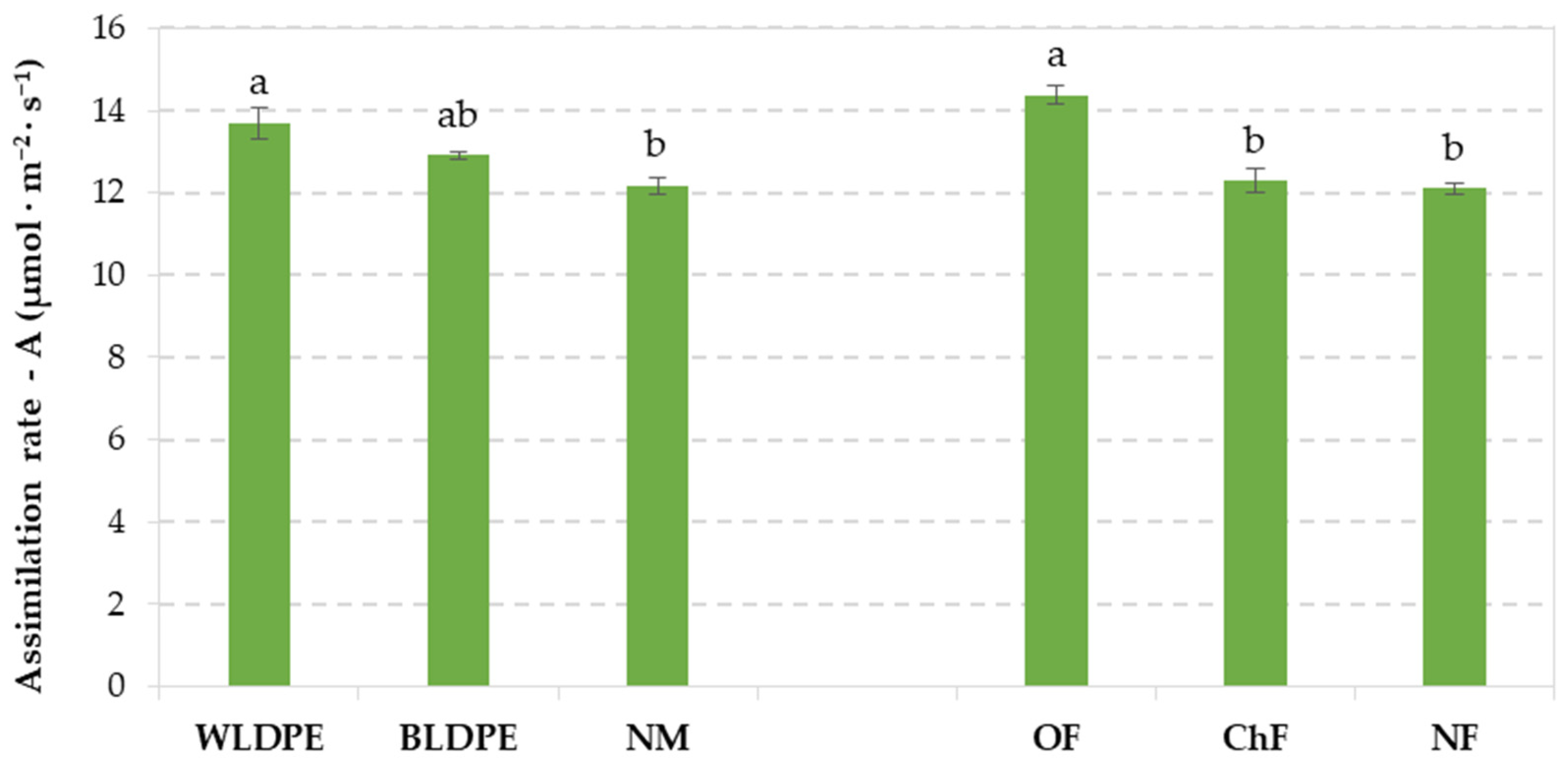

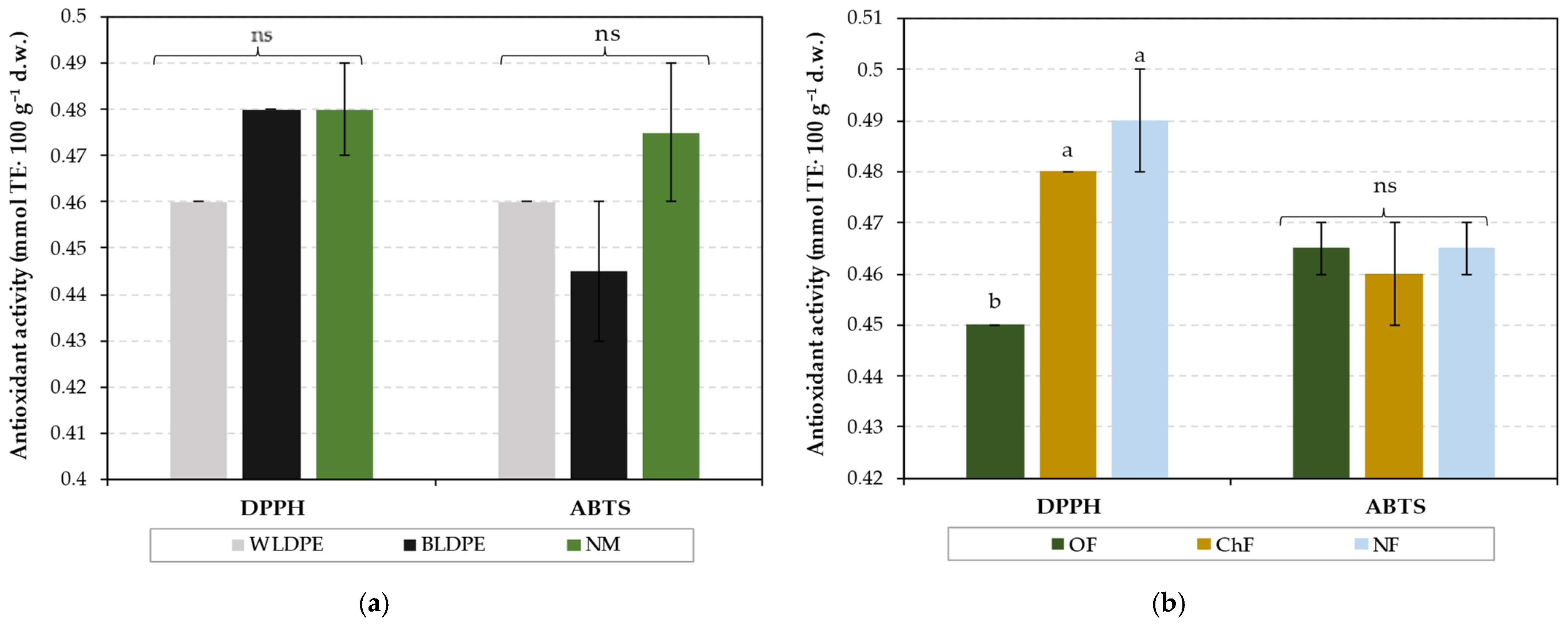

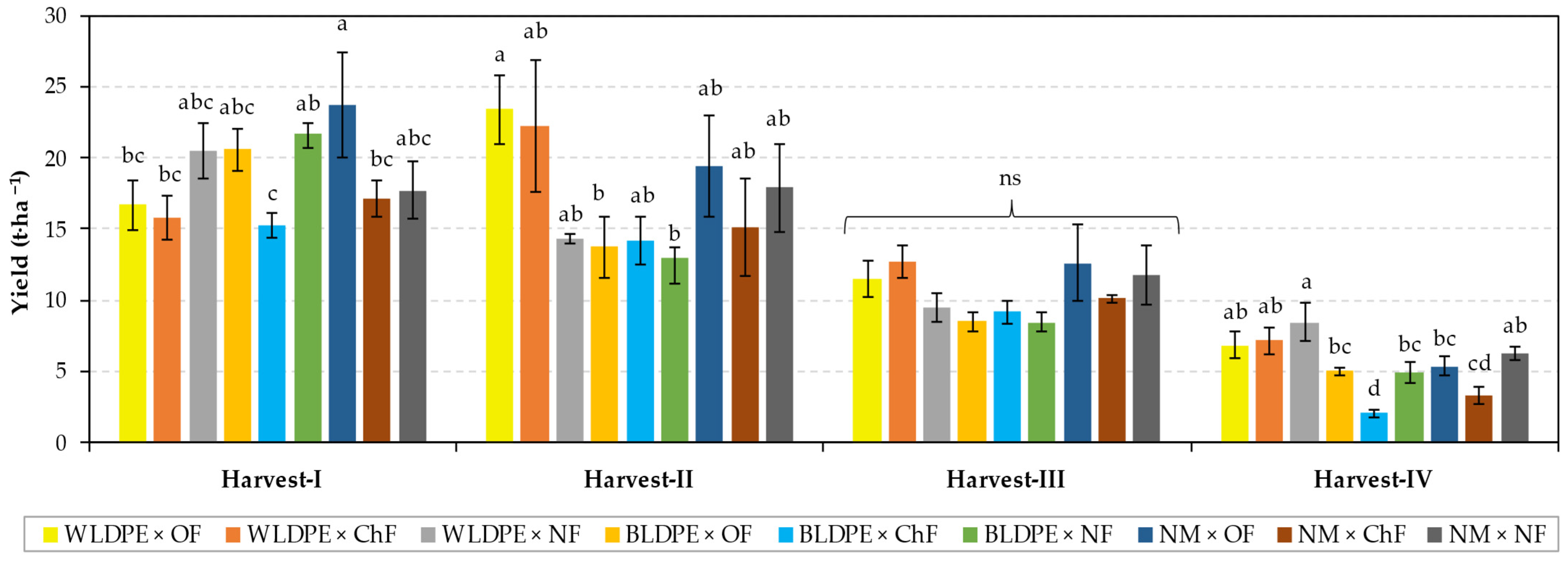

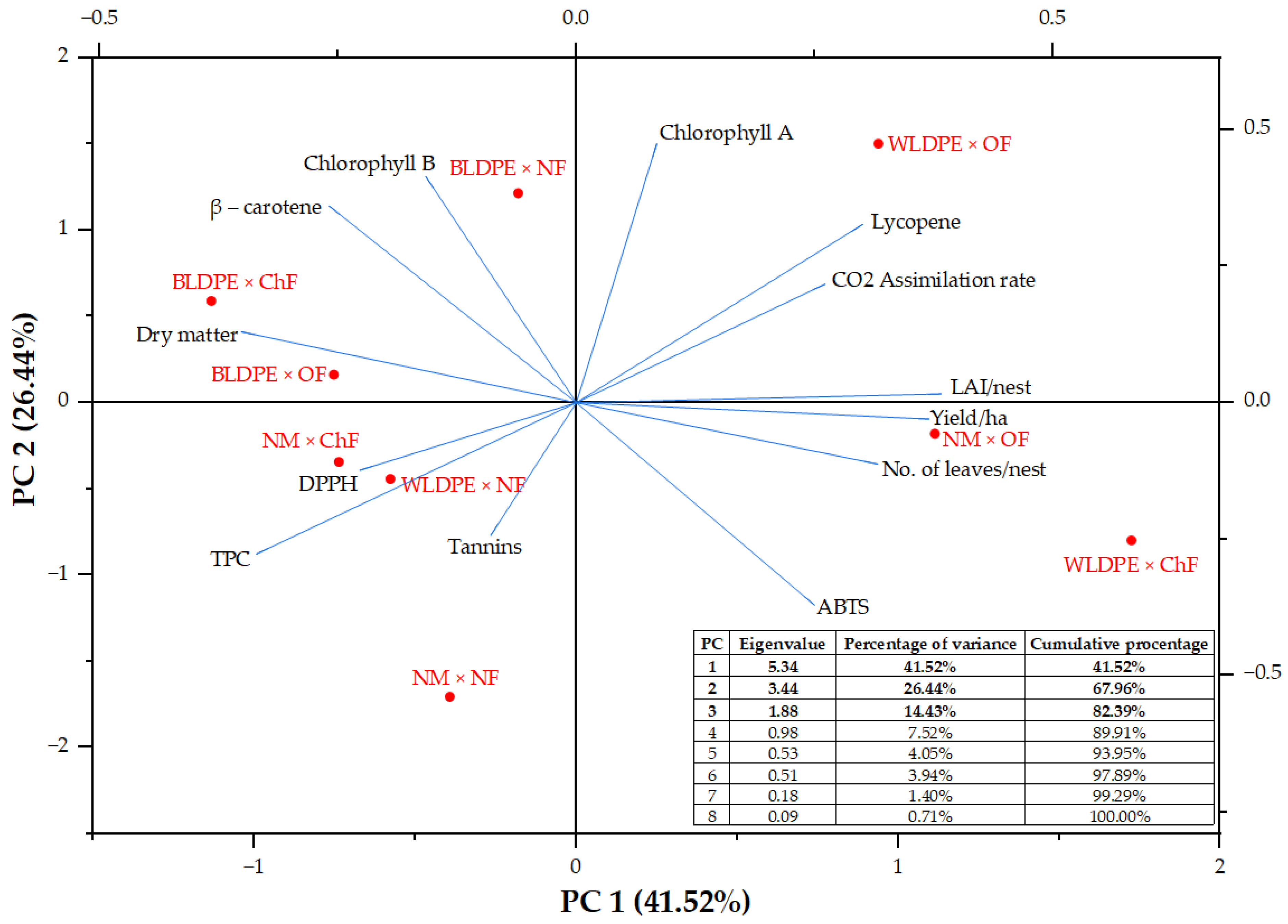

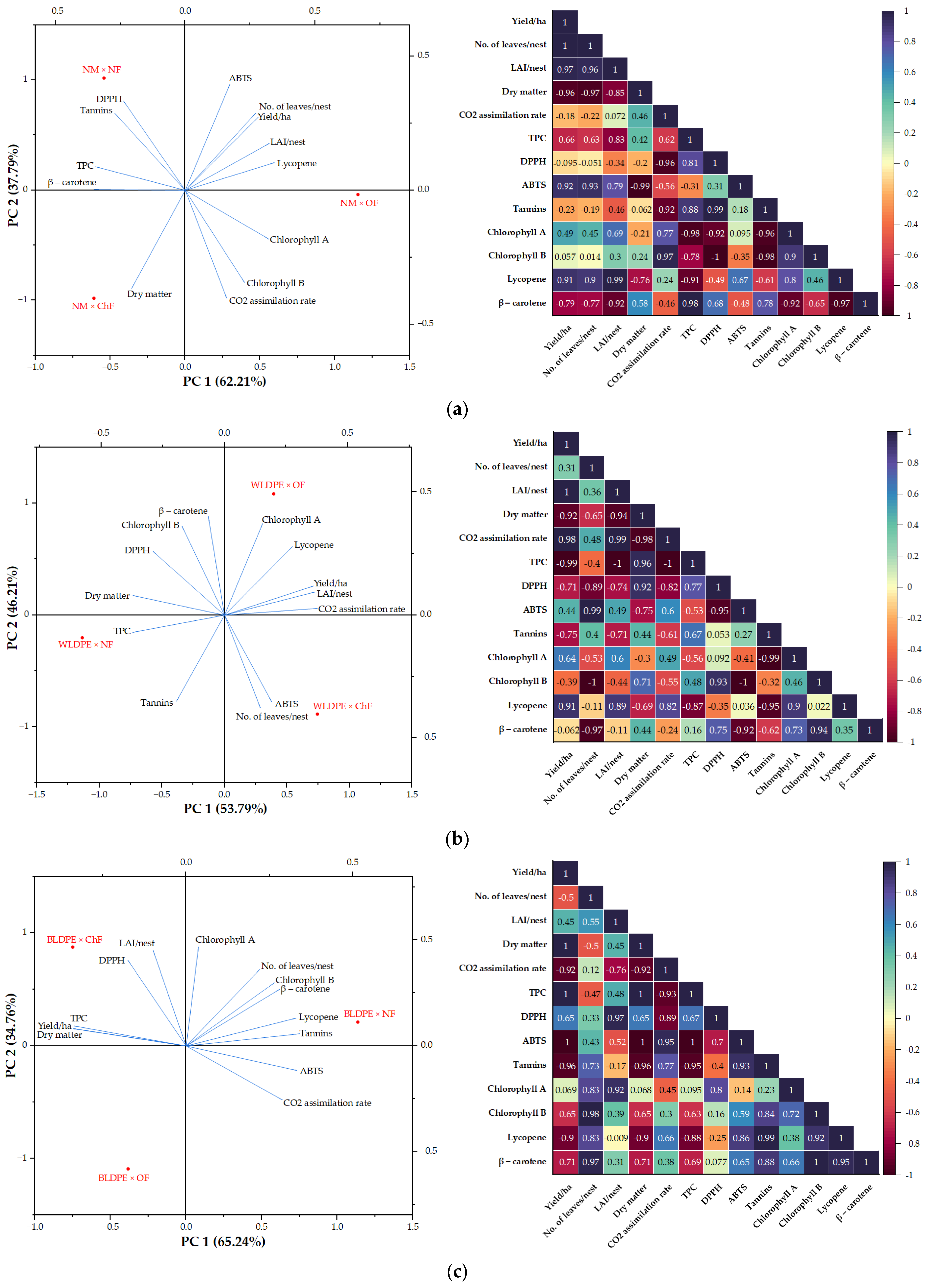
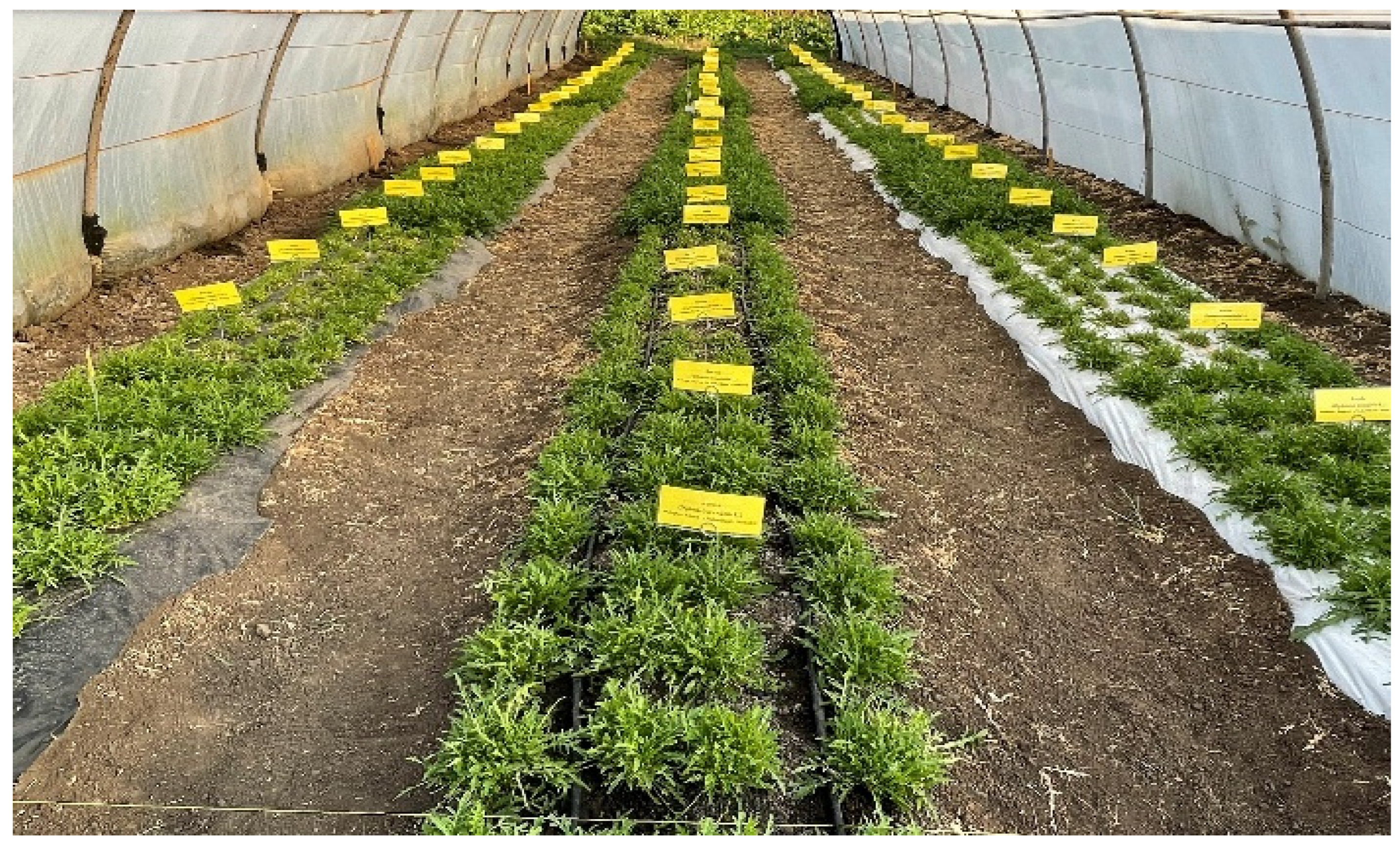

| Experimental Variant | Leaves/Nest | LAI (cm2·cm−2) | Total Yield | |
|---|---|---|---|---|
| Nest (g) | t·ha−1 | |||
| WLDPE | 660.67 ± 24.20 | 11,309.75 ± 416.52 a | 633.31 ± 25.22 a | 56.36 ± 2.24 a |
| BLDPE | 577.33 ± 23.30 | 9481.05 ± 269.29 b | 511.64 ± 11.76 b | 45.54 ± 1.05 b |
| NM | 634.00 ± 27.05 | 10,895.45 ± 505.19 ab | 601.38 ± 42.59 ab | 53.52 ± 3.79 ab |
| Significance | ns | * | * | * |
| OF | 636.44 ± 17.77 | 11,027.83 ± 330.97 | 627.24 ± 18.42 | 55.82 ± 1.64 |
| ChF | 591.67 ± 13.83 | 10,090.26 ± 562.68 | 540.61 ± 39.11 | 48.11 ± 3.48 |
| NF | 643.89 ± 39.86 | 10,568.16 ± 422.30 | 578.47 ± 19.98 | 51.48 ± 1.78 |
| Significance | ns | ns | ns | ns |
| Experimental Variant | Dry Matter (%) | TPC (mg GAE·100 g−1 d.w.) | Tannins (mmol·100 g−1 d.w.) |
|---|---|---|---|
| WLDPE | 8.29 ± 0.07 b | 1.95 ± 0.11 | 0.06 ± 0.01 |
| BLDPE | 8.95 ± 0.09 a | 1.98 ± 0.15 | 0.06 ± 0.01 |
| NM | 8.59 ± 0.11 b | 2.04 ± 0.08 | 0.06 ± 0.01 |
| Significance | * | ns | ns |
| OF | 8.51 ± 0.07 | 1.91 ± 0.12 | 0.06 ± 0.01 |
| ChF | 8.79 ± 0.08 | 1.99 ± 0.13 | 0.06 ± 0.01 |
| NF | 8.53 ± 0.12 | 2.07 ± 0.10 | 0.06 ± 0.00 |
| Significance | ns | ns | ns |
| Experimental Variant | Chlorophyll a (mg·100 g−1 d.w.) | Chlorophyll b (mg·100 g−1 d.w.) | Lycopene (mg·100 g−1 d.w.) | β-Carotene (mg·100 g−1 d.w.) |
|---|---|---|---|---|
| WLDPE | 93.14 ± 1.97 | 36.00 ± 0.33 | 9.76 ± 0.21 | 4.77 ± 0.05 b |
| BLDPE | 93.45 ± 0.82 | 39.12 ± 0.83 | 9.40 ± 0.19 | 5.99 ± 0.23 a |
| NM | 87.24 ± 2.86 | 35.70 ± 1.18 | 9.17 ± 0.27 | 4.6 ± 0.26 b |
| Significance | ns | ns | ns | * |
| OF | 94.92 ± 0.15 | 37.05 ± 0.18 | 9.73 ± 0.05 | 5.03 ± 0.29 |
| ChF | 91.21 ± 2.25 | 35.81 ± 1.04 | 9.29 ± 0.19 | 4.91 ± 0.20 |
| NF | 89.25 ± 1.17 | 38.18 ± 1.02 | 9.41 ± 0.22 | 5.36 ± 0.01 |
| Significance | ns | ns | ns | ns |
| Experimental Variant | Leaves/Nest | LAI (cm2·cm−2) | TOTAL YIELD | |
|---|---|---|---|---|
| Nest (g) | t·ha−1 | |||
| WLDPE × OF | 655.00 ± 27.75 a | 11,328.77 ± 196.48 ab | 656.78 ± 10.13 ab | 58.45 ± 0.90 ab |
| WLDPE × ChF | 670.67 ± 36.55 a | 11,556.13 ± 1245.31 ab | 650.73 ± 83.00 abc | 57.91 ± 7.39 abc |
| WLDPE × NF | 656.33 ± 28.85 a | 11,044.36 ± 265.19 ab | 592.42 ± 9.34 abcd | 52.73 ± 0.83 abcd |
| BLDPE × OF | 591.00 ± 20.07 ab | 9715.37 ± 443.82 bc | 537.68 ± 23.29 bcd | 47.85 ± 2.07 bcd |
| BLDPE × ChF | 519.67 ± 35.03 b | 8842.67 ± 450.49 c | 457.10 ± 22.34 d | 40.68 ± 1.99 d |
| BLDPE × NF | 621.33 ± 29.49 ab | 9885.11 ± 513.22 abc | 540.12 ± 22.92 bcd | 48.07 ± 2.04 bcd |
| NM × OF | 663.33 ± 31.17 a | 12,039.34 ± 970.78 a | 687.26 ± 66.15 a | 61.17 ± 5.89 a |
| NM × ChF | 584.67 ± 15.07 ab | 9871.99 ± 325.64 abc | 514.01 ± 28.82 cd | 45.75 ± 2.56 cd |
| NM × NF | 654.00 ± 66.30 a | 10,775.01 ± 681.02 abc | 602.87 ± 41.90 abc | 53.66 ± 3.73 abc |
| Experimental Variant | Dry Matter (%) | TPC (mg GAE·100 g−1 d.w.) | Tannins (mmol·100 g−1 d.w.) |
|---|---|---|---|
| WLDPE × OF | 8.21 ± 0.01 cd | 1.84 ± 0.12 | 0.06 ± 0.01 abc |
| WLDPE × ChF | 8.05 ± 0.10 d | 1.84 ± 0.02 | 0.06 ± 0.01 abc |
| WLDPE × NF | 8.61 ± 0.29 bc | 2.17 ± 0.19 | 0.06 ± 0.00 ab |
| BLDPE × OF | 8.91 ± 0.20 ab | 1.99 ± 0.17 | 0.06 ± 0.01 abc |
| BLDPE × ChF | 9.27 ± 0.08 a | 2.05 ± 0.17 | 0.05 ± 0.00 bc |
| BLDPE × NF | 8.65 ± 0.03 bc | 1.90 ± 0.12 | 0.06 ± 0.00 ab |
| NM × OF | 8.40 ± 0.01 cd | 1.90 ± 0.04 | 0.05 ± 0.01 c |
| NM × ChF | 9.04 ± 0.24 ab | 2.10 ± 0.20 | 0.06 ± 0.01 abc |
| NM × NF | 8.33 ± 0.10 cd | 2.14 ± 0.01 | 0.07 ± 0.01 a |
| Significance | * | ns | * |
| Experimental Variant | Chlorophyll a (mg·100 g−1 d.w.) | Chlorophyll b (mg·100 g−1 d.w.) | Lycopene (mg·100 g−1 d.w.) | β-Carotene (mg·100 g−1 d.w.) |
|---|---|---|---|---|
| WLDPE × OF | 101.45 ± 3.74 a | 38.47 ± 0.90 ab | 10.16 ± 0.36 a | 5.74 ± 0.31 abc |
| WLDPE × ChF | 89.51 ± 1.15 bcd | 32.47 ± 0.08 c | 9.73 ± 0.16 ab | 3.80 ± 0.07 d |
| WLDPE × NF | 88.45 ± 1.00 bcd | 37.07 ± 0.01 b | 9.38 ± 0.10 ab | 4.77 ± 0.09 cd |
| BLDPE × OF | 87.79 ± 2.33 bcd | 35.87 ± 0.29 bc | 9.19 ± 0.07 ab | 5.68 ± 0.55 abc |
| BLDPE × ChF | 97.45 ± 5.17 ab | 39.05 ± 2.16 ab | 9.25 ± 0.51 ab | 5.96 ± 0.19 ab |
| BLDPE × NF | 95.13 ± 0.38 abc | 42.45 ± 0.62 a | 9.78 ± 0.14 ab | 6.35 ± 0.33 a |
| NM × OF | 90.88 ± 0.95 bcd | 36.16 ± 0.02 bc | 9.54 ± 0.01 ab | 3.86 ± 0.19 d |
| NM × ChF | 86.69 ± 2.73 cd | 35.91 ± 1.06 bc | 8.89 ± 0.23 b | 4.98 ± 0.34 bc |
| NM × NF | 84.16 ± 4.89 d | 35.03 ± 2.45 bc | 9.07 ± 0.61 ab | 4.95 ± 0.25 bc |
| Traits | Extracted Eigenvectors | |||||||
|---|---|---|---|---|---|---|---|---|
| PC1 | PC2 | PC3 | PC4 | PC5 | PC6 | PC7 | PC8 | |
| Yield/ha | 0.370 | −0.030 | 0.179 | −0.334 | 0.375 | −0.061 | 0.225 | 0.181 |
| No. of leaves/nest | 0.383 | 0.016 | 0.211 | −0.341 | 0.078 | 0.014 | 0.141 | 0.185 |
| LAI/nest | −0.352 | 0.130 | −0.163 | −0.310 | 0.013 | 0.460 | −0.297 | 0.261 |
| Dry matter | 0.261 | 0.217 | −0.389 | 0.321 | 0.287 | 0.132 | 0.003 | 0.603 |
| CO2 assimilation rate | −0.336 | −0.277 | 0.048 | −0.075 | −0.104 | 0.235 | 0.670 | 0.163 |
| TPC | −0.227 | −0.124 | 0.561 | −0.182 | −0.053 | −0.227 | −0.227 | 0.331 |
| DPPH | 0.250 | −0.371 | 0.002 | 0.269 | −0.220 | −0.405 | −0.177 | 0.203 |
| ABTS | −0.090 | −0.243 | 0.451 | 0.456 | 0.470 | 0.319 | −0.010 | 0.044 |
| Tannins | 0.084 | 0.475 | 0.257 | −0.224 | −0.141 | 0.011 | −0.111 | 0.130 |
| Chlorophyll a | −0.158 | 0.414 | 0.157 | 0.327 | −0.369 | −0.185 | 0.380 | 0.320 |
| Chlorophyll b | 0.301 | 0.327 | 0.209 | 0.135 | −0.006 | 0.194 | 0.225 | −0.433 |
| Lycopene | −0.259 | 0.360 | 0.197 | 0.221 | 0.303 | −0.157 | −0.205 | −0.097 |
| β-carotene | 0.370 | −0.030 | 0.179 | −0.334 | 0.375 | −0.061 | 0.225 | 0.181 |
Disclaimer/Publisher’s Note: The statements, opinions and data contained in all publications are solely those of the individual author(s) and contributor(s) and not of MDPI and/or the editor(s). MDPI and/or the editor(s) disclaim responsibility for any injury to people or property resulting from any ideas, methods, instructions or products referred to in the content. |
© 2025 by the authors. Licensee MDPI, Basel, Switzerland. This article is an open access article distributed under the terms and conditions of the Creative Commons Attribution (CC BY) license (https://creativecommons.org/licenses/by/4.0/).
Share and Cite
Precupeanu, C.; Rădeanu, G.; Teliban, G.-C.; Roșca, M.; Ordóñez-Díaz, J.L.; Moreno-Rojas, J.M.; Stoleru, V. Effects of Mulch and Fertilization on the Quantity and Quality of Perennial Wall–Rocket (Diplotaxis tenuifolia). Plants 2025, 14, 1421. https://doi.org/10.3390/plants14101421
Precupeanu C, Rădeanu G, Teliban G-C, Roșca M, Ordóñez-Díaz JL, Moreno-Rojas JM, Stoleru V. Effects of Mulch and Fertilization on the Quantity and Quality of Perennial Wall–Rocket (Diplotaxis tenuifolia). Plants. 2025; 14(10):1421. https://doi.org/10.3390/plants14101421
Chicago/Turabian StylePrecupeanu, Cristina, Georgiana Rădeanu, Gabriel-Ciprian Teliban, Mihaela Roșca, José Luis Ordóñez-Díaz, Jose Manuel Moreno-Rojas, and Vasile Stoleru. 2025. "Effects of Mulch and Fertilization on the Quantity and Quality of Perennial Wall–Rocket (Diplotaxis tenuifolia)" Plants 14, no. 10: 1421. https://doi.org/10.3390/plants14101421
APA StylePrecupeanu, C., Rădeanu, G., Teliban, G.-C., Roșca, M., Ordóñez-Díaz, J. L., Moreno-Rojas, J. M., & Stoleru, V. (2025). Effects of Mulch and Fertilization on the Quantity and Quality of Perennial Wall–Rocket (Diplotaxis tenuifolia). Plants, 14(10), 1421. https://doi.org/10.3390/plants14101421










